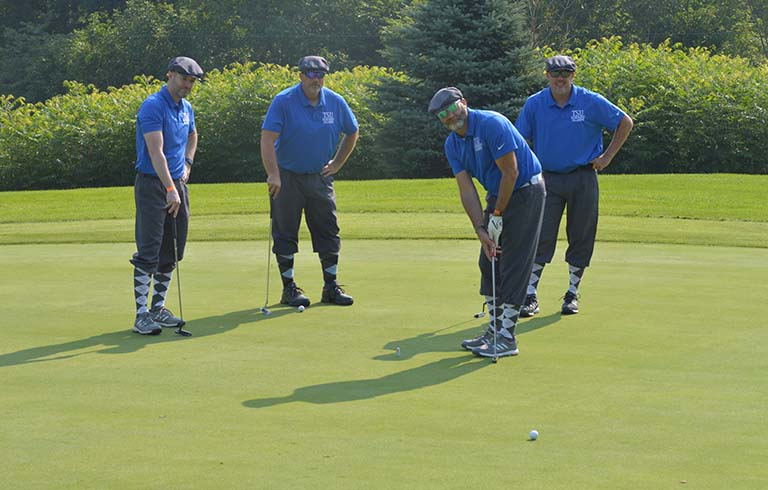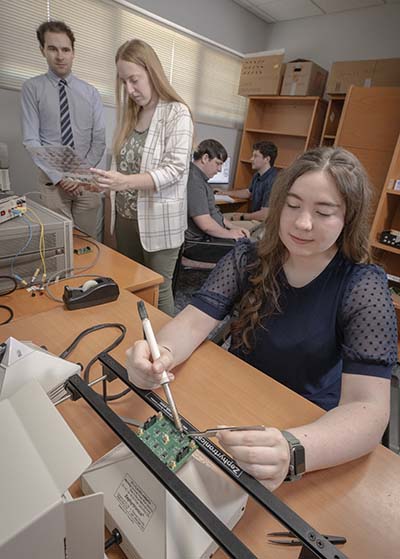
Golfers enjoy beautiful weather while raising nearly $100K for scholarships
It was a perfect day for golf and a perfect day to support Trine University students.
August 19, 2025

MEMS resonators, strands of silicon narrower than a human hair, are found in everything from computers to cell phones, vibrating to allow devices to keep time and sense movement.
Funded by $200,000 grant from the National Science Foundation, a Trine University faculty member and students are researching how to make them better.
Doing the math
James Miller, Ph.D., assistant professor in the Wade Department of Mechanical and Aerospace Engineering, said MEMS resonators are like a guitar string, and the research seeks to determine if increasing tension on them — similar to tightening a guitar string to tune it — will make their frequencies more stable.
Tension is applied using a shuttle structure made up of capacitors that reduce in gap size in response to applied voltage.
“This mechanical tension increases the resonance frequency, which we mathematically showed can improve the frequency stability,” he said.
Mechanical engineering majors Maranda Padfield of Kokomo, Indiana, Janna Wilson of Kokomo, Indiana, Nicholas Ewing of Wabash, Indiana, and Nathan Stefanski of Almont, Michigan, are assisting with the research.
Ewing, who first heard of the opportunity when discussing the possibility of graduate school, said he was attracted to the project by its interdisciplinary nature.
“I liked the idea of being able to stay close to software, since that is a big passion of mine, while also doing mechanical engineering,” he said. “I felt like I would really enjoy it even if I didn’t end up pursuing graduate school after finishing my degree.”
Padfield was intrigued by the ubiquity of MEMS.
“They’re in almost all the technology that is used in the modern day, and yet, most people, me included, know little about them,” she said. “It also opens a completely new door into more research later down the line in grad school or the corporate world.”
Stefanski said he has been interested in research since childhood, and the opportunity to conduct research has solidified for him that it’s a career part he wants to follow.
“There's a great deal of intellectual freedom involved, but it seems like a job that never gets boring,” he said. “That's the kind of future I envision.”
Noise reduction
The team began researching devices that apply increased tension earlier this summer, with the students taking measurements and running simulations to confirm the shuttle structure works as intended. The next step is to investigate the effects of increasing tension on the frequency stability.
“The students are helping to show whether the real world conforms to the theoretical predictions I made,” Dr. Miller said.
The team also has investigated techniques to reduce noise in MEMS resonator devices, which will improve their resonance frequency stability.
Ewing said he and Stefanski have been researching methods of reducing the noise by adjusting the stiffness of the resonator to amplify or suppress motion.
“I’ve primarily worked on the code side of things because I’m more comfortable in that area due to my professional experience,” he said. “This includes creating, modifying and debugging code to take measurements on our devices, and also creating code to compile measurement data into figures for (the group’s) paper.”
Through the research, Dr. Miller said the students learn about semiconductor devices, microelectronics, mathematical modeling and computer programming, which provides valuable skills for technology sector jobs and engineering graduate school.
Stefanski said the project has also allowed the team to meet and interact with professionals at weekly "lab lunches" hosted by Dr. Miller.
“Many of them began as mechanical engineering students but have since transitioned into roles focused on health, fitness or computer science — all still connected to MEMS,” Stefanski said. “One of the biggest lessons I've taken away is the value of having a wide skill set and diverse experiences.”
Formative research opportunities
The team is already preparing a journal article about its research to be published as well as individual abstracts to be presented at a MEMS conference next year.
Dr. Miller said he hopes to secure additional funding after the current grant concludes in August 2026.
“I hope to continue to provide formative research opportunities to Trine University undergraduate students through follow-up research projects,” he said.
Padfield said conducting the research has been “an incredible learning experience for me.”
“I have learned so much about analyzing these devices, coding in MATLAB, and a few modeling programs that I had never used before, such as COMSOL,” she said. “We’ve had the amazing opportunity to hear from Dr. Miller as well as many speakers in this field, and each one has had so much helpful advice for this field and life in general.”
“As a mechanical engineering student, my software and electrical skills have grown leaps and bounds,” said Wilson. “This has been a great first summer of collaborating with Dr. Miller and my co-workers, and I am looking forward to continuing to learn and discover.”